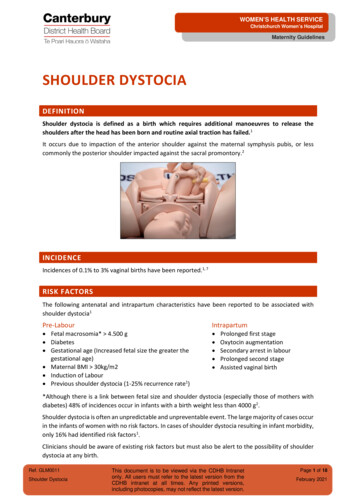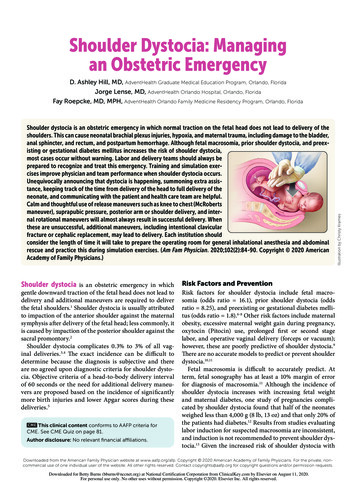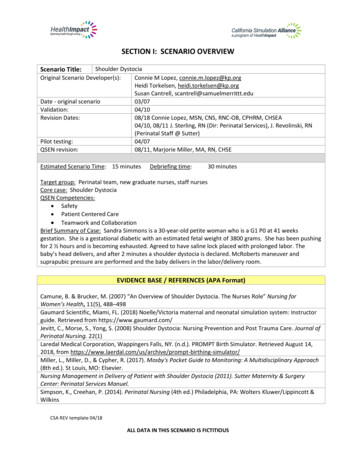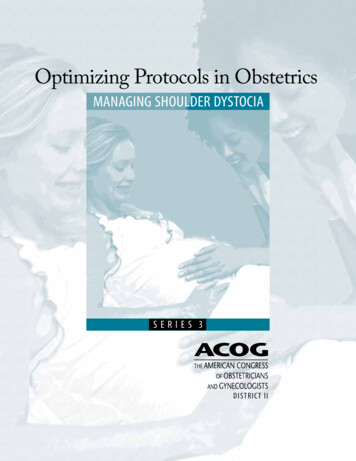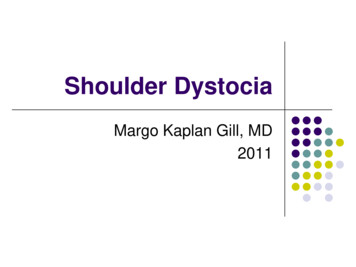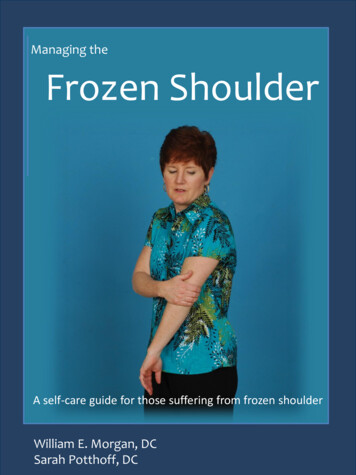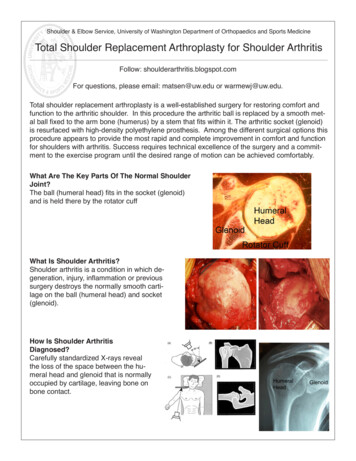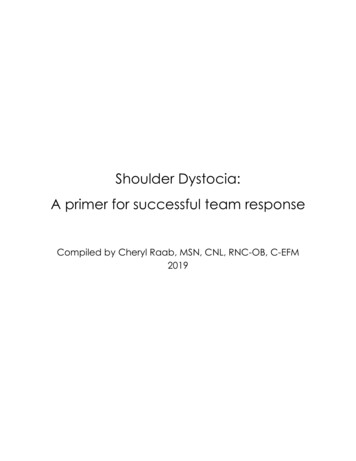
Transcription
Shoulder Dystocia:A primer for successful team responseCompiled by Cheryl Raab, MSN, CNL, RNC-OB, C-EFM2019
TABLE OF CONTENTSSECTION 1BACKGROUND . 1Definition . 1Prevalence. 1Risk Factors . 1Recognition . .1Complications . 2SECTION 2MANAGEMENT . 3Initial steps .3Maneuvers .4McRoberts . 4Suprapubic pressure . 4Episiotomy . 4Delivery of the posterior arm . 4Rubins . 5Woods corkscrew . 5Gaskin . 6Fracture of clavicle . 7Zavanelli . 7Abdominal rescue. 7SECTION 3TEAMWORK & COMMUNICATION . 8Simulation training . 8Team training. 8Debriefing . 9Documentation . 10SECTION 4TEST YOURSELF . 11Shoulder Dystocia Crossword Puzzle . 11Multiple Choice Questions . 12REFERENCES . 15
BACKGROUNDShoulder dystocia is the nightmare of many obstetric providers and nurses. Shoulder dystocia during a deliverycan rapidly change a happy, anxiously awaited event to one of anxiety, fear and concern as it can culminate in injury,death and litigation. Complicating this is the fact that shoulder dystocia is both unpredictable and unpreventable. Butthe situation is not hopeless. Instead knowledge, communication and team preparation can produce positive outcomes. DEFINITION – ACOG defines shoulder dystocia as delivery that requires additional obstetric maneuversfollowing failure of gentle downward traction on the fetal head to effect delivery of the shoulders. Othershave defined shoulder dystocia as a head-to-body delivery time exceeding 60 seconds or the need for ancillaryobstetric maneuvers. Ultimately the definition is a subjective one and only the delivering provider can makethe call. PREVALENCE – Because of the use of various definitions, it is difficult to be certain as to the exact prevalenceof shoulder dystocia. Additionally, severe cases of shoulder dystocia are easily identified but mild cases maybe over or under diagnosed. Reported incidence is anywhere between 0.2 to 3.0% of all vaginal deliveries invertex presentation. RISK FACTORS – Risk factors exist in the antepartum and intrapartum periods. Antepartum risk factors –o Diabeteso Maternal obesity ( 200 lbs. / BMI 30)o Excessive weight gaino Multiparityo Post term gestationo Macrosomiao History of a previous shoulder dystociao Abnormal pelvic anatomyo Short maternal stature ( 5 feet tall) Intrapartum risk factors –o Prolonged active phase of laboro Failure or arrest of descento Midpelvis operative vaginal deliveryo Precipitous delivery Women without identified risk factors may experience a shoulder dystocia RECOGNITION & DIAGNOSIS – Despite the list of risk factors, shoulder dystocia is difficult to predict.Scenarios that may foreshadow shoulder dystocia include: Prolonged second stage Difficulty or failure to accomplish external rotation of the head after it has passed the perineum Turtle sign – after its delivery, retraction of the fetal head against the maternal perineumcreating the appearance of a double chin.1
Resistance to the delivery of the anterior shoulder with the usual gentle downward tractionapplied to the fetal headCOMPLICATIONS - Shoulder dystocia places both the mother and fetus at high risk for birth-related injury Maternal Complicationso Uterine atony / Postpartum hemorrhageo 3rd or 4th degree laceration / rectovaginal fistulao Uterine rupture Fetal Complications – a minority of shoulder dystocia’s result in neonatal injury; reported ratesare 4-40%o Brachial plexus palsy – may be temporary or permanento Fractured clavicle / humeruso Hypoxic ischemic encephalopathyo Neonatal death2
MANAGEMENTShoulder dystocia is an obstetric emergency. A systematic, step by step approach to the management of ashoulder dystocia is a key primary risk reduction strategy. Further information related to the steps listed below can befound in the subsequent pages.Step 1 – Planning Think about shoulder dystocia before every delivery but remember that there is no way toconclusively predict it in a given patient.In the setting of suspicion for shoulder dystocia, all team members should be made aware ofthe possibility. A shared mental model is key to teamwork.Nursing staff should assure the presence of one or two step stools in the room.Step 2 – Announce the situation Obstetric Provider: Announce the presence of a shoulder dystociaNurse: Utilizing the intercom system, inform the BA and charge nurse of the shoulderdystociaBA: Make an overhead page of “Shoulder dystocia, Rm ”.Step 3 – Communicate The nurse will discontinue Pitocin infusion, if one is infusing. It can be started again followingresolution of the dystociaThe obstetric provider and nurse should calmly communicate the occurrence of the shoulderdystocia to the patient and familyInstruct the mother not to push while maneuvers are implementedStep 4 – Maneuvers Maneuvers are sometimes referred to as First Line, Second Line and Extraordinary/DesperationManeuversMcRobert’s and suprapubic pressure may be performed by nursing staff at the request of thedelivering provider. All other maneuvers are the responsibility of the MD/CNM providerStep 5 – Debrief Following completion of the delivery, staff should debrief the events of the shoulder dystociaStep 6 – Documentation It is important that documentation be accurate and comprehensive to demonstrate appropriatestandard of care in the event of litigation.3
ManeuversKnowledge of the use and application of various obstetric maneuvers is key to the intrapartum management ofshoulder dystocia. There are no randomized trials that demonstrate the superiority of some maneuvers over others forresolving shoulder dystocia once it is identified. Both nursing and medical providers should have a basic understandingof all maneuvers and their role in utilizing them.First Line Maneuvers: McRobert’s maneuver – requires 2 assistants sharply flexing the patient’s legs against theabdomen. This results in straightening the sacrum relative to the lumbar vertebrae. Suprapubic pressure – an assistant applies pressure downward and laterally against theposterior aspect of the anterior shoulder. This is usually done in conjunction with McRobert’s.Do not apply fundal pressure.UpToDateSecond Line Maneuvers: Episiotomy – does not help to release the shoulder dystocia but may be helpful in providingroom prior to performing the following maneuvers. Episiotomy does increase the incidence ofperineal trauma. Delivery of the posterior arm – should be considered following McRobert’s maneuver andsuprapubic pressure as an appropriate next maneuver.o Best performed with adequate anesthesiao Introduce a hand into the vagina to identify the posterior shoulder and armo If the elbow is flexed, grab the forearm and hand and pull the arm out of the vaginao If the elbow is extended, apply pressure to the antecubital fossa, which causes theelbow to flex and proceed as above4
Delivery of the Posterior ArmClinical Procedures in Emergency Medicine Rotational maneuvers – may be helpful in facilitating release of the shoulder dystociao Rubin maneuver –insert a hand into the vagina and place it on the back surface of theposterior fetal shoulder and rotate it towards the fetal faceRubin ManeuverUpToDateoWoods corkscrew maneuver – place a hand into the vagina on the anterior, clavicularsurface of the posterior shoulder to turn the fetus until the anterior shoulder emergesfrom behind the maternal symphysis5
Woods corkscrew ManeuverUpToDate Gaskin maneuver – is done by placing the patient in the all fours position allowing furtherdescent of the posterior shoulder past the sacral promontory; this position facilitates rotationalmaneuvers or delivery of the posterior armo Due to the change in maternal position it is important to re-orient yourself regarding theapplication of further maneuvers6
Extraordinary / Desperation Maneuvers: Intentional fracture of the clavicle- Unintentional fracture of the clavicle is a not uncommonoccurrence in the setting of a shoulder dystocia. Intentional fracture of the clavicle has beenutilized to enable delivery by collapsing the shoulder girdle and freeing the impacted shoulder.o Accomplished by hooking the fingers behind the midpoint of the clavicle and exertingpressure up and out. Zavanelli maneuver – cephalic replacement through reversal of the cardinal movements oflabor: rotation of the fetal head to pre-restitution position; flexion of the fetal head; applicationof pressure to return the head into the vagina; followed by cesarean delivery Abdominal rescue – vaginal delivery utilizing direct pressure on the fetal shoulder either throughan abdominal incision with an intact uterus or through a low transverse uterine incision7
TEAMWORK AND COMMUNICATIONRecognition of a shoulder dystocia and facilitating proper interventions and timely delivery of the infant are thegoals of the care delivery team. Communicating effectively as interdisciplinary teams is essential to meeting these goals.Strategies to develop teamwork and communication include: simulation training and team training. Simulation Training – a recreation of real world situations that allow for learning in an interactivemanner without exposing caregivers or patients to harm; utilized to develop effective communication,within and between teamso Simulation and shoulder dystocia in the literature Crofts et al. (2015) – 0 cases of brachial plexus injury lasting 12 months in 562 cases ofshoulder dystocia one decade after simulation training introduced Deering, Weeks & Benedetti (2011) – gender, body habitus and provider experiencewere not predictive of how much force a provider applies on the fetal head during asimulated shoulder dystocia Crofts et al. (2006) – training with mannequins improved the management of shoulderdystocia; training on high-fidelity mannequins including force monitoring, offeredadditional benefits Goffman, Heo, Pardanani, Merkatz & Bernstein (2008) - Shoulder dystocia simulationtraining improved communication skills among resident and attending physicians Team Training – a comprehensive program that includes strategies and tools to facilitate teamworkbehaviors.o Key Principles: Team structure – “The ratio of We’s to I’s is the best indicator of the development of ateam”, Lewis B. Ergen Clearly defined team Infrastructure for decision-making, care delivery & communication Identification of Team roles during a shoulder dystocia:1. Delivery provider – Team leader; identify the situation; focused onperforming delivery maneuvers2. Delivery nurse – Vigilance; alerts the team and mobilizes resources;assigns roles to other team members3. Recorder – Maintains situational awareness for the team; documentsteam actions and time of action; timekeeper – call out time intervals tomaintain situational awareness of team4. Anesthesia personnel – Appropriate pain control to allow maneuvers5. Neonatal personnel –Stabilization and assessment of the newborn;resuscitation as required Leadership – “Leadership: the art of getting someone else to do something you wantdone because he wants to do it.:, Dwight D. Eisenhower Effective leaders create the climate that allows teamwork to flourish8
Empowers team members to speak up and challenge decisions whenappropriate Establish shared mental modelSituation monitoring – “Attention to detail is one of the most important details”, AuthorUnknown The process of actively scanning and assessing elements of the situation tomaintain an accurate understanding of the situation in which the teamfunctions Toolso Cross checkingo STARMutual support – “A chain is only as strong as its weakest link:, Author Unknown Types of mutual supporto Task assistanceo Timely feedbacko Advocacy & assertion Stop the Line Validate & verifyCommunication – “Communication is the response you get from the message you sentregardless of its intent”, Author Unknown Standardized communication is key to effective teamwork Effective communication is:o Completeo Clearo Briefo Timely Toolso SBARo Repeat Backs / Read Backso Clarifying questionsDebriefingDebriefing is an information-sharing and event-processing session held following specific events. Debriefing,done immediately following an event, provides the opportunity for the team to learn while memories are fresh. In thecase of shoulder dystocia, this offers the opportunity to confirm timing of the events and maneuvers so thatdocumentation is consistent from one member of the team to another. Debriefings also provide an opportunity for theteam to talk about their feelings related to the event. One useful model of debriefing involves four sections: defusing,debriefing, deepening and a summary.9
1. Defusing – How do staff feel about the event? This allows team to vent their feelings and emotionsconcerning the event.2. Debriefing – What was done well? What are areas for improvement? This allows the team toreflect on the event and allows them to be an active part of the solution.3. Deepening – How can these lessons be used to improve performance in future events? This allowsthe team to connect the experience to actual practice.4. Summary – What are the take away points? This allows for agreement on actions moving forward.DocumentationShoulder dystocia leading to brachial plexus injuries is among the top reasons for litigation in obstetric events.ACOG has a Patient Safety Checklist concerning documenting shoulder dystocia that is an excellent guide to criticalelements of both antepartum and intrapartum documentation for shoulder dystocia. All of these elements are alsofound within the Epic electronic medical record. Deering, Tobler & Cypher (2010) concluded that use of a standardchecklist for shoulder dystocia in the delivery note resulted in a significant improvement in the documentation of severalcritical elements.10
11
Multiple Choice Shoulder Dystocia Questions1. A shoulder dystocia becomes evidentA. When the patient “crowns”B. With upward traction on the fetal headC. At the beginning of second stageD. Following failure of normal downward traction on the fetal head to effect delivery2. The term shoulder dystocia indicates thatA. Anterior shoulder is obstructed behind the coccyxB. Anterior shoulder is obstructed behind the symphysisC. Posterior shoulder is obstructed behind the symphysisD. The fetus is in OP position3. Indicators of a shoulder dystocia areA. Postdates and labor inductionB. Fetal macrosomia and prolonged second stage of laborC. Prolonged first stage of labor and early SROMD. Prolonged second stage of labor and a turtle sign4. Patients are at higher risk for shoulder dystocia in the presence of the followingA. DiabetesB. MacrosomiaC. HypertensionD. All of the aboveE. A & B5. Maternal complications following a shoulder dystocia include all of the following exceptA. Dysuria and constipationB. Suprapubic painC. Postpartum hemorrhageD. Uterine rupture6. The Zavanelli maneuver is also referred to asA. Cephalic rotationB. Fundal pressureC. Cephalic replacementD. Suprapubic pressure12
7. It is within nursing scope of practice to perform the following maneuvers if necessaryA. Suprapubic pressure and McRobert’s maneuverB. Fundal pressure and McRobert’s maneuverC. Wood’s corkscrew and Ruben’s maneuverD. Delivery of the posterior arm8. An episiotomy is performed during a shoulder dystocia toA. Relieve the obstruction to the posterior shoulderB. Relieve umbilical cord compressionC. Allow more room to perform other maneuversD. Allow suctioning of the infant’s mouth9. Forceful traction on the fetal head is not helpful to effect delivery during a shoulder dystocia becauseA. The anterior shoulder is obstructed by soft tissueB. The anterior shoulder is obstructed behind the symphysisC. The infant most likely has a nuchal cordD. It will serve to further impact the shoulder10. Following a shoulder dystocia which actions should occurA. The events of the delivery are explained to the patient and her familyB. The care team should refrain from talking about the delivery with the patient and familyC. The care team should debrief the events of the deliveryD. A & CE. B & C11. During a shoulder dystocia, someone should be assigned the role of recorderA. To maintain situational awareness for the teamB. To record the maneuvers applied and the time of the applicationC. To announce time since delivery of the head at designated intervalsD. All of the aboveE. None of the aboveConsider the following scenario:Rebecca is a primip at 41 1 weeks gestation. She has gained 50 lbs during this pregnancy and her fetus has an EFW6.5 lbs. An epidural is placed during the first stage of labor. After pushing for 3 hours, the head of hermale infant is delivered from an OA position and a tight nuchal cord is clamped and cut. The fetal head retractsagainst the perineum and no further progress is noted. The nurse initiates McRobert’s maneuver and appliessuprapubic pressure at the direction of the delivering provider. The infant’s Apgar scores are 6 at 1 minute and 9 at5 minutes. The infant is noted to have a right fractured clavicle. The mother experiences a postpartumhemorrhage.13
12. The least likely cause of the postpartum hemorrhage isA. Cervical lacerationsB. Uterine ruptureC. Atonic uterusD. Rectal trauma13. Risk factors for shoulder dystocia in this scenario includeA. Excessive maternal weight gainB. Epidural anesthesiaC. Prolonged laborD. None of the above14. Besides the fractured clavicle, additional fetal complications of shoulder dystocia includeA. Hypoxic ischemic encephalopathyB. Fetal hypoglycemiaC. Brachial plexus injuryD. A & CE. B & C15. In documenting the events of Rebecca’s delivery all of the following should be included exceptA. Time interval between delivery of the head and the bodyB. That an event report will be filedC. Names of all staff presentD. Which was the involved shoulderE. Maneuvers utilized and the sequence in which they were appliedF. Condition of the newborn at birth14
REFERENCESAmerican College of Obstetricians and Gynecologists. Shoulder Dystocia. Practice Bulletin No. 178. Washington, DC:American College of Obstetricians and Gynecologists; 2017American College of Obstetricians and Gynecologists. (2012). Documenting shoulder dystocia, Patient Safety ChecklistNo. 6. Obstetrics & Gynecology, 120(2), 430-431Anderson, J. E. (2012). Complications of labor and delivery: shoulder dystocia. Primary Care: Clinics in Office Practice, 39,135-144Bennett, B. B. (1999). Shoulder dystocia: An obstetric emergency. Obstetrics and Gynecology Clinics of North America,26(3), 445-458Camune, B. & Brucker, M. C. (2007). An overview of shoulder dystocia: The nurse’s role. Nursing for Women’s Health,11(5). 489-497Crofts, J. F., Bartlett, C., Ellis, D., Hunt, L. P., Fox, R., & Draycott, T. J. (2006). Training for shoulder dystocia: a trial ofsimulation using low-fidelity and high-fidelity mannequins. Obstetrics & Gynecology, 108(6), 1477-1485Crofts, J. F. , Lenguerrand, E., Bentham, G. L., Tawfik, S., Claireaux, H. A., Odd, D., Draycott, T. J. (2015). Prevention ofbrachial plexus injury – 12 years of shoulder dystocia training: an interrupted time-series study. BJOG: An InternationalJournal of Obstetrics and Gynaecology, 123(1), 111-118Daniels, L.T. & Simpson, E.K. (2009). Integrating team training strategies into obstetrical emergency simulation training.Journal for Healthcare Quality, 31(5), 38-42Deering, S. H., Tobler, K. & Cypher, R. (2010). Improvement in documentation using an electronic checklist for shoulderdystocia deliveries. Obstetrics & Gynecology, 116(1), 63-66Deering, S. H., Weeks, L. & Benedetti, T. (2011). Evaluation of force applied during deliveries complicated by shoulderdystocia using simulation. American Journal of Obstetrics & Gynecology, 204, 234.e1-234.e5Goffman, D., Heo, H., Pardanani, S., Merkatz, I. R., & Bernstein, P. S. (2008). Improving shoulder dystocia managementamong resident and attending physicians using simulations. American Journal of Obstetrics and Gynecology, 199(3), 294e1.Grobman, W. (2013). Shoulder dystocia. Obstetrics and Gynecology Clinics of North America, 40, 59-67Hoffman, M. K., Bailit, J. L., Branch, D. W., Burkman, R. T., Van Veldhusien, P., Lu, L., Zhang, J. for the Consortium onSafe Labor. (2011). A comparison of obstetric maneuvers for the acute management of shoulder dystocia. Obstetrics &Gynecology, 117(6), 1272-1278Ramsey, P. S., Ramin, K. D. & Field, C. S. (2000). Shoulder dystocia: Rotational maneuvers revisited. Journal ofReproductive Medicine, 45(2), 85-88Sagi-Dain, L. & Sagi, S. (2015). The Role of Episiotomy in Prevention and Management of Shoulder Dystocia:A Systematic Review. Obstetrical and Gynecological Survey, 70(5), 354-36215
Spong, C. Y., Beall, M., Rodrigues, D., & Ross, M. G. (1995). An objective definition of shoulder dystocia: prolonged headto-body delivery intervals and/or the use of ancillary obstetric maneuvers. Obstetrics & Gynecology, 86(3), 433-436.TeamSTEPPS 2.0 September 2015. Agency for Healthcare Research and Quality, Rockville, riculum-tools/teamstepps/instructors/index.html16
DEFINITION - ACOG defines shoulder dystocia as delivery that requires additional obstetric maneuvers following failure of gentle downward traction on the fetal head to effect delivery of the shoulders. Others have defined shoulder dystocia as a head-to-body delivery time exceeding 60 seconds or the need for ancillary obstetric maneuvers.
